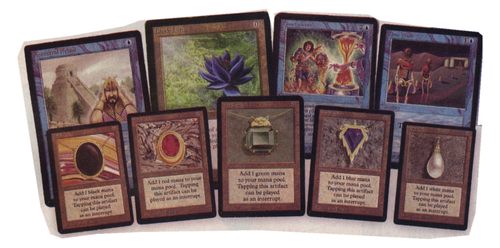
Ever since I started playing Yu-Gi-Oh with my friends in middle-school, I have been trying to design my own cards. I started out making new cards for the characters on the show to use (what if they made a fusion of Blue-Eyes White Dragon and Red-Eyes B. Dragon?!), and then moved on to making my own custom decks and archetypes.
Eventually I moved on to inventing my own games entirely, and had to come up with entire decks or groups of cards to play with. In this process I learned a number of things, but one of the most challenging was how to evaluate a card once it was made. Was it good or bad? Strong or weak? It was often really hard to tell.
Over the years, both through playtesting my own games and playing other trading card games, I began to develop a system for measuring a card’s strength. I think that this system could be helpful both for designers who wish to make their own trading cards, or for new players trying to get a handle on evaluating cards.
To help keep this article consistent I am going to be using Magic cards as my example, but many of these principles can be applied to other games such as Hearthstone with a few minor adjustments. I also want to make it known that I am not a professional-caliber magic player, and this article is not designed to help you become the world’s greatest Magic drafter. However, if you are new to the game I hope that some of these principles can help.
Also, because Magic is such a huge game with thousands of unique cards throughout it’s history I will not be able to hit everything in a single article. For today I am going to focus primarily on evaluating basic creatures, as well as some simple abilities. Next time I will look at some more complicated creature abilities, as well as spell effects.
Vanilla is my Favorite Flavor
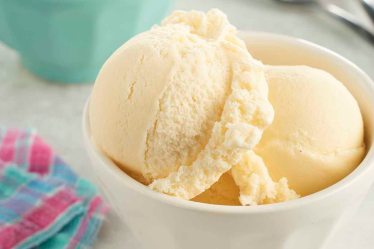
Magic creatures have a wide range of different powers, toughnesses, abilities and costs, all of which can make it extremely difficult to determine how strong a particular card is. Because of this, for the first part of this article I am going to be focusing on what are called “Vanilla Creatures”, which simply means that they don’t have any abilities. This will help simplify the issue, and we will move on to more complicated creatures further down.
Probably the most important thing that determines a creature’s power is it’s mana cost. This cost has two main components. The first component is what is known as the “converted mana cost”, which is the total amount of mana required to play the card. Creatures with higher converted mana costs tend in most cases tend to be stronger than those of lower costs. This part is pretty straightforward.
The second part of the mana cost is a little less obvious, but no less important. The amount, and types, of colored mana in a card’s cost can greatly affect it’s power level. The reason for this is that by adding more colored mana to a particular card’s cost, you make it less flexible, and less able to be played in a variety of decks.
The more mana of a particular color is in the cost, the more dedicated the deck must be to that particular color. This is further amplified if the card has multiple colors – the deck must play all of the colors to play the card, which limits it to a very particular set of decks.
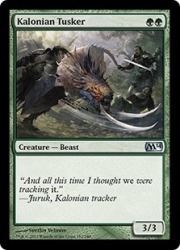
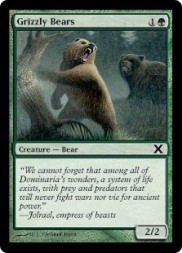 These two cards both have the same converted mana cost – 2 – and they are both green creatures. However, the Kalonian Tusker is clearly the more powerful creature – a 3/3, as opposed to a 2/2. The reason for this is that Kalonian Tusker is a lot more narrow card. In order to consistently cast it on turn 2, the player pretty much has to be playing only green. If you are playing two or more colors, then the odds go up that you won’t be able to play the tusker until your 3rd turn or beyond, and it’s value begins to diminish.
These two cards both have the same converted mana cost – 2 – and they are both green creatures. However, the Kalonian Tusker is clearly the more powerful creature – a 3/3, as opposed to a 2/2. The reason for this is that Kalonian Tusker is a lot more narrow card. In order to consistently cast it on turn 2, the player pretty much has to be playing only green. If you are playing two or more colors, then the odds go up that you won’t be able to play the tusker until your 3rd turn or beyond, and it’s value begins to diminish.
So how much does 1 mana get you? In most cases, you would expect that every mana is going to give your creature about 2 points divided among power and toughness. So, 2 mana can get you a 3/1, a 2/2, a 1/3, or a 0/4. 3 mana can get you a 3/3, and 6 mana can get you a 6/6.
There are a few exceptions to this, however. First off, it is generally accepted that a point of power is worth more than a point of toughness, so sometimes creatures with high power will have fewer “points” than creatures with more balanced stats, and very high toughness creatures might have more.
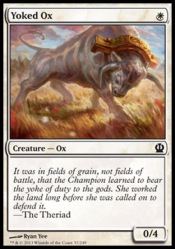
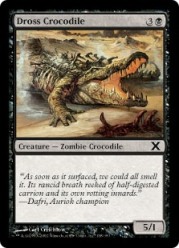 In addition, really lopsided stats are generally seen as less favorable. For example, a creature with high power but only 1 toughness is easily killed by a much weaker creature, while a creature with 0 power basically loses it’s functionality as an attacker, and in return gets bonus points in toughness.
In addition, really lopsided stats are generally seen as less favorable. For example, a creature with high power but only 1 toughness is easily killed by a much weaker creature, while a creature with 0 power basically loses it’s functionality as an attacker, and in return gets bonus points in toughness.
Finally, for every additional colored mana in the cost you can expect about 1 additional point, although this varies. Early on in the game additional colored mana is more of a restriction, which is why you can get a full +1/+1 on Kalonian Tusker. On a card with a converted mana cost of 6, however, 2 green mana is not nearly as much of a restriction and you would expect less of a bonus.
A Bear of a Different Color
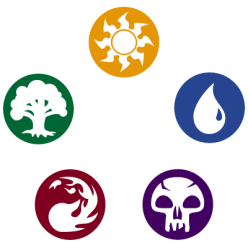
Another thing that has a major effect on a creature’s strength is it’s color. Different colors in Magic treat creatures differently, and this will change
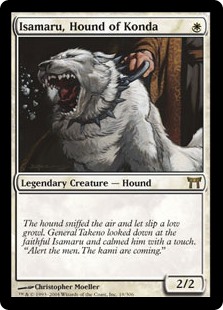
how the creatures themselves are evaluated. White, generally, gets the best small creatures. This can be shown on cards such as Elite Vanguard and Isamaru, Hound of Konda – no other color can get those stats for the same cost.
Green, on the other hand, tends to get the most efficient large creatures. Green’s creatures just tend to be bigger on average than the other colors, and once you get past 3 mana most other colors just can’t compete with it’s size.
As far as the other colors go, blue is generally considered to have the worst creatures, followed by red and finally black. Because of this imbalance, a creature that might seem pretty weak in green might also be one of the best creatures in your deck in blue.
Aside from some colors simply having better creatures than others, a card’s color also has an effect on the way stats are distributed on the card. White and blue tends to have the best defensive creatures, and has the most low power/high toughness creatures. Red and black, on the other hand, tend to have the most creatures with higher power than toughness (especially red). Green sits pretty squarely in the middle – it can have highly defensive or highly aggressive creatures, but it tends to be the most balanced.
A Rare Opportunity
Another factor that unfortunately has a very high correlation with a card’s power is it’s rarity. I’m not going to say too much about this particular point, as it is relatively straightforward. Higher rarities, in general, have better cards. I wish this weren’t the case, but the facts are the facts.
This is why cards with the same exact mana cost in the same set can have such extreme 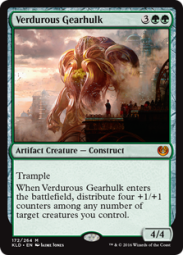
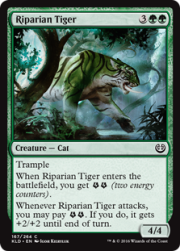 disparities in power. Take these two cards for instance – Riparian Tiger and Verdurous Gearhulk. At common you have a creature that must pay 2 energy to give itself +2/+2 until end of turn. On the other hand, at Mythic Rare you have a creature that can freely give any creature +4/+4 permanently for free when it enters the battlefield. Clearly there is a huge disparity in the power level of these cards, but aside from rarity and ability they are completely identical.
disparities in power. Take these two cards for instance – Riparian Tiger and Verdurous Gearhulk. At common you have a creature that must pay 2 energy to give itself +2/+2 until end of turn. On the other hand, at Mythic Rare you have a creature that can freely give any creature +4/+4 permanently for free when it enters the battlefield. Clearly there is a huge disparity in the power level of these cards, but aside from rarity and ability they are completely identical.
A French Connection
For most of this article I have been talking about vanilla creatures with no abilities. However, most of the Magic creatures you encounter are going to have some abilities. While it would be impossible for me to talk about every possible ability that you might encounter on a Magic card, in this section I am gonna talk about a particular type of creatures abilities – what is known as the “french vanilla”.
If vanilla creatures represent the most basic a creature can be, french vanilla is only one step up from that. They are creatures that only have what are known as “evergreen keywords”, which are abilities that show up in pretty much every set.
- Flying
Flying is probably the most basic ability to be found among Magic creatures, to the point 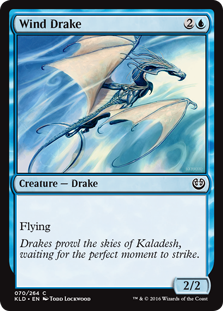 that a creature that has flying and nothing else could almost be considered vanilla. However, despite it’s simplicity and ubiquity flying is still an incredibly valuable ability.
that a creature that has flying and nothing else could almost be considered vanilla. However, despite it’s simplicity and ubiquity flying is still an incredibly valuable ability.
When evaluating a flying creature, the general rule of thumb is that it should cost 1 more mana than an equivalent non-flying creature. However, this is not a hard and fast rule. Every color treats flying creatures differently, and will cost them accordingly. Blue tends to have the best flyers, followed by white, and then black. Red doesn’t get flyers very often, but when it does it is usually on dragons. Green is the most anti-flying color – they rarely get flyers, and they are usually overcosted.
Because flying is an ability that makes the creature difficult to block, high power is usually more expensive than high toughness. An unchecked flying creature can potentially win a game all by itself, and every additional point of power can end the game even sooner.
- First Strike / Double Strike
I grouped these two together because they work similarly, although they are actually evaluated quite differently. Evaluating a card with first strike is a little tricky, because it significantly changes how combat works, but the easiest way to think about it is that it wins ties. Basically if you and the other creature would normally kill eachother, instead you kill it and you survive.
Creatures with first strike tend to have higher power than toughness, which makes sense because the only way for them to even damage you is if you don’t kill it first. This, in addition to being able to win ties, means that first strike is generally worth about half a mana extra, which usually results in one less power/toughness than a comparable creature without first strike.
Double strike, on the other hand, is generally quite a bit more powerful. Not only does
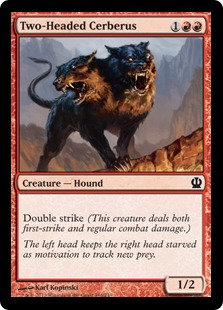
the creature deal it’s damage twice (which means that it should be evaluated as basically having twice as much power as it actually does), but it also interacts incredibly well with pumping abilities. For every extra point of power you give to a Double-Striker, it will basically gain two.
When evaluating a double-striker, I will generally count each of it’s points of power twice, add it’s toughness, and then add 2 more points on top of this. For this reason, I would generally expect a 2/2 double-striker to cost about 4 mana.
- Defender
Unlike the abilities above, defender is actually not a benefit to the creature that has it. It is actually a draw-back, which means that the creature can afford to have somewhat better stats or an additional upside ability to make up for it. I would generally expect creatures with defender to be about 1 mana cheaper than a corresponding creature without defender.
That’s All for This Week
I know that I wasn’t able to cover everything this week, and there are so many different abilities and card types left un-analyzed. However, this is all the time I have for this week, so I will have to finish the rest another time. If you liked this article, and would like to see more like it in the future, be sure to subscribe to the blog on Facebook, Twitter, or here on WordPress so you will always know when I post a new article. I don’t always talk about Magic the Gathering, but I like to cover all sorts of different topics in game design, strategy and history. If you didn’t like this article, let me know what I could be doing better in the comments below! And join me next time, where I will be talking all about solved games!

2 replies on “How Good is it? Basic Tips for Evaluating Magic Cards”